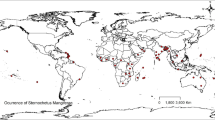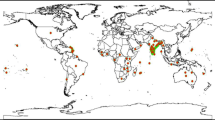Abstract
Wilt of mango caused by Ceratocystis fimbriata has become a great threat to mango production in Bangladesh, Brazil, Oman, Pakistan, Spain and very recently in India also. In the present study potential distribution of mango wilt in India was predicted under different climate change scenarios by ecological niche modeling by MaxEnt. Study revealed that cutting across the different scenarios precipitation of wettest month, precipitation seasonality, temperature seasonality, isothermality were the significant factors in determining the disease distribution. Highest suitability areas for the disease occurrence under current scenario was predicted in southern parts of Jammu and Kashmir, southern Himachal Pradesh and Uttarakhand, western and central Uttar Pradesh, western part of Bihar, western part of Maharashtra and Karnataka. Under future climate scenarios in 2050 highest suitability areas were predicted in parts of southern Jammu and Kashmir and western Bihar; whereas in 2070 scenario the highest suitability of disease occurrence was predicted in Uttar Pradesh, Jammu Kashmir, Bihar, Himachal Pradesh and Madhya Pradesh. This study provides important information on the risk of C. fimbriata wilt using a MaxEnt model in India. The results can be utilized in strategic planning to prevent further spread of disease.






Similar content being viewed by others
References
Al-Adawi AO, Deadman ML, Al Rawahi AK, Al Maqbali YM, Al Jahwari AA, Al Saadi BA, Al Amri IS, Wingfield MJ (2006) A etiology and causal agents of mango sudden decline disease in the Sultanate of Oman. Eur J Plant Pathol 116:247–254
Al-Yahani R, Khan IA, Deadman A (2005) Citrus and mango. International tropical fruits workshop. Chron Hortic 45(3):42–43
Austin MP (2002) Spatial prediction of species distribution: an interface between ecological theory and statistical modelling. Ecol Model 157(2–3):101–118
Bastos CN, Evans HC (1978) Occurrence of Ceratocystis fimbriata Ell. & Halst. in Brazilian Amazonia. Acta Amazon 8(4):543–544
Deadman M, Al-Adawi A, Al-Yahyai R, Wingfield MJ (2007) Ceratocystis wilt of mango in Oman. In: Proceedings of the International Symposium on Prospects of Horticulture Industry in Pakistan, Publisher: Institute of Horticultural Sciences, University of Agriculture, Faislabad, pp 191-4
Fateh FS, Kazmi MR, Ahmad I, Ashraf M (2006) Ceratocystis fimbriata isolated from vascular bundles of declining mango trees in Sindh, Pakistan. Pak J Bot 38:1257–1259
Galdino TV, Kumar S, Oliveira LS, Alfenas AC, Neven LG, Al-Sadi AM, Picanço MC (2016) Mapping global potential risk of mango sudden decline disease caused by Ceratocystis fimbriata. PLoS One 11(7):e0159450. https://doi.org/10.1371/journal.pone.0159450
Gundappa, Shukla PK, Misra AK (2016) Status of mango wilt vector, Hypocryphalus mangiferae in India. Indian Phytopathol 69(4s):361–363
Jiskani MM (2002) Dying of mango orchards needs special attention. Pakistan and Gulf Economist, Karachi, March 18–24
Jones VP, Hilton R, Brunner JF, Bentley WJ, Alston DG, Barrett B, Van Steenwyk RA, Hull LA, Walgenbach JF, Coates WW, Smith TJ (2013) Predicting the emergence of the codling moth, Cydia pomonella (Lepidoptera: Tortricidae), on a degree-day scale in North America. Pest Manag Sci 69(12):1393–1398
Kumar S, Neven LG, Zhu H, Zhang R (2015) Assessing the global risk of establishment of Cydia pomonella (Lepidoptera: Tortricidae) using CLIMEX and MaxEnt niche models. J Econ Entomol 108(4):1708–1719
Masood A, Shafqat S, Asif S, Mudassar A (2009) Life cycle and biology of mango bark beetle, Hypocryphalus mangifera Stebbing: as a possible vector of sudden death disease of mango. Pak J Zool 41:281–288
Masood A, Saeed S, Mahmood A, Malik SA, Hussain N (2012) Role of nutrients in management of mango sudden death disease in Punjab, Pakistan. Pak J Zool 44(3):675–683
Misra AK (2004) Wilt, a new serious problem in mango production in India. In: Proceedings of National Symposium on detection and management of plant diseases using conventional and modern tools, 2004. Lucknow, India: CISH, pp 12–13
NHB Database (2017) National Horticulture Board, Department of Horticulture and Cooperation, Government of India, Aristo Printing Press, New Delhi. http://www.nhb.gov.in
Oliveira LSS, Guimaraes LMS, Ferreira MA, Nunes AS, Pimenta LVA, Alfenas AC (2015) Aggressiveness, cultural characteristics and genetic variation of Ceratocystis fimbriata on Eucalyptus spp. Forest Pathology. https://doi.org/10.1111/efp.12200
Peterson AT, Soberón J, Pearson RG, Anderson RP, Martínez-Meyer E, Nakamura M, Araújo MB (2011) Ecological niches and geographic distributions (MPB-49) (Vol. 56). Princeton University Press
Ploetz RC, Prakash O (1997) Foliar, floral and soil borne diseases. In: Litz RE (ed) The mango: botany, production and uses. CABI Publishing, UK, pp 281–326
Rajan S (2012) Phenological responses to temperature and rainfall: A case study of mango. Bioversity International Office for South Asia, National Agricultural Science Centre, DPS Marg, Pusa Campus, New Delhi 110 012, India
Rajan S, Ravishankar H, Tiwari D, Singh VK, Saxena P, Singh S, Reddy YTN, Upreti KK, Burondkar MM, Bhagwan A, Kennedy R (2013) Harmonious phenological data: a basic need for understanding the impact of climate change on mango. In: Climate-resilient horticulture: adaptation and mitigation strategies. Springer, India, pp 53–65
Rossetto CJ, Ribeiro IJA (1990) Mango wilt. XII. Recommendations for control. Revista de Agricultura (Piracicaba) 65(2):173–180
Saeed S, Masood A, Sajjad A, Zahid DM (2010) Monitoring the dispersal potential of bark beetle, Hypocryphalus mangiferae Stebbing (Scolytidae: Coleoptera) in mango orchards. Pak J Zool 42(4):473–479
Shukla PK, Varma S, Fatima T, Mishra R, Misra AK, Bajpai A, Gundappa MM (2018) First report on wilt disease of mango caused by Ceratocystis fimbriata in Uttar Pradesh. Indian Phytopathol 71(1):135–142
Silveira SF, Harrington TC, Mussi-Dias V, Engelbrecht CJB, Alfenas AC, Silva CR (2006) Annona squamosa, a new host of Ceratocystis fimbriata. Fitopatol Bras 31(4):394–397. https://doi.org/10.1590/S0100-41582006000400010
Sonyal S, Pappachan A, Palanna KB, Mahesha HS, Manjunath S, Hurakadli GMS (2015) Survival ability of Ceratocystis fimbriata causing pomegranate wilt in different temperature and hydrogen ion concentration (pH). Int J Pure Appl Biosci 3(4):49–53
Webster R, Butler E (1967) A morphological and biological concept of the species Ceratocystis fimbriata. Canadian J Bot 45:1457–1468
Zhang ZP, Li Q, Luo LX, Li QJ, Hao JJ (2017) First report of mango wilt caused by Ceratocystis fimbriata in Mangifera indica in China. APS Publ https://doi.org/10.1094/PDIS-10-16-1477-PDN
Acknowledgements
Authors are thankful to the Director, CISH, Lucknow for providing facilities for carrying out the work. Thanks are also due to Indian Council of Agricultural Research, New Delhi for providing financial assistance under National Initiative of Climate Resilient Agriculture (NICRA) Project entitled, “Understanding the changes in host pest interactions and dynamics in mango under climate change scenario” and ICAR-ERP –“Development of effective management strategy against wilt disease of mango”, which facilitated survey of larger area.
Author information
Authors and Affiliations
Corresponding author
Additional information
Publisher’s note
Springer Nature remains neutral with regard to jurisdictional claims in published maps and institutional affiliations.
Rights and permissions
About this article
Cite this article
Shukla, P.K., Baradevanal, G., Rajan, S. et al. MaxEnt prediction for potential risk of mango wilt caused by Ceratocystis fimbriata Ellis and Halst under different climate change scenarios in India. J Plant Pathol 102, 765–773 (2020). https://doi.org/10.1007/s42161-020-00502-9
Received:
Accepted:
Published:
Issue Date:
DOI: https://doi.org/10.1007/s42161-020-00502-9




